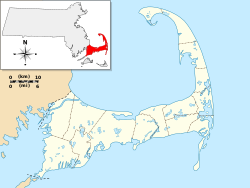Jedediah Higgins House | |
 HABS photo, 1962 | |
| Nearest city | North Truro, Massachusetts |
|---|---|
| Coordinates | 42°0′35″N70°3′6″W / 42.00972°N 70.05167°W |
| Area | 7 acres (2.8 ha) |
| Built | 1890 |
| NRHP reference No. | 84000550 [1] |
| Added to NRHP | November 21, 1984 |
The Jedediah Higgins House is a historic house on Higgins Hollow Road in North Truro, Massachusetts. It is one of the least altered 19th-century Cape style houses in the Cape Cod National Seashore, and an excellent early example of that style. It is a 1+1⁄2-story post-and-beam house, whose front facade typifies the Cape style: a central doorway flanked by windows on either side. Its interior floor plan is also typical, with two rooms on the south side and one large one to the north, with a central chimney. Interior finishes have also been preserved, including wood flooring, paneling, and wainscoting. [2]
The house was listed on the National Register of Historic Places in 1984. [1]



